2006 CHEVROLET MALIBU fuel
[x] Cancel search: fuelPage 1 of 442
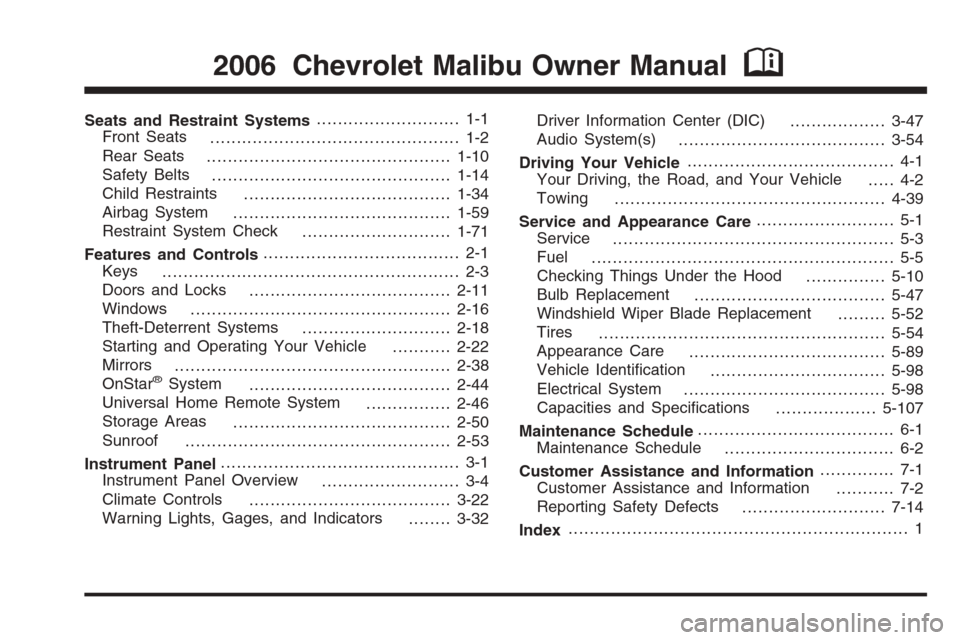
Seats and Restraint Systems........................... 1-1
Front Seats
............................................... 1-2
Rear Seats
..............................................1-10
Safety Belts
.............................................1-14
Child Restraints
.......................................1-34
Airbag System
.........................................1-59
Restraint System Check
............................1-71
Features and Controls..................................... 2-1
Keys
........................................................ 2-3
Doors and Locks
......................................2-11
Windows
.................................................2-16
Theft-Deterrent Systems
............................2-18
Starting and Operating Your Vehicle
...........2-22
Mirrors
....................................................2-38
OnStar
®System
......................................2-44
Universal Home Remote System
................2-46
Storage Areas
.........................................2-50
Sunroof
..................................................2-53
Instrument Panel............................................. 3-1
Instrument Panel Overview
.......................... 3-4
Climate Controls
......................................3-22
Warning Lights, Gages, and Indicators
........3-32Driver Information Center (DIC)
..................3-47
Audio System(s)
.......................................3-54
Driving Your Vehicle....................................... 4-1
Your Driving, the Road, and Your Vehicle
..... 4-2
Towing
...................................................4-39
Service and Appearance Care.......................... 5-1
Service
..................................................... 5-3
Fuel
......................................................... 5-5
Checking Things Under the Hood
...............5-10
Bulb Replacement
....................................5-47
Windshield Wiper Blade Replacement
.........5-52
Tires
......................................................5-54
Appearance Care
.....................................5-89
Vehicle Identi�cation
.................................5-98
Electrical System
......................................5-98
Capacities and Speci�cations
...................5-107
Maintenance Schedule..................................... 6-1
Maintenance Schedule
................................ 6-2
Customer Assistance and Information.............. 7-1
Customer Assistance and Information
........... 7-2
Reporting Safety Defects
...........................7-14
Index................................................................ 1
2006 Chevrolet Malibu Owner ManualM
Page 87 of 442
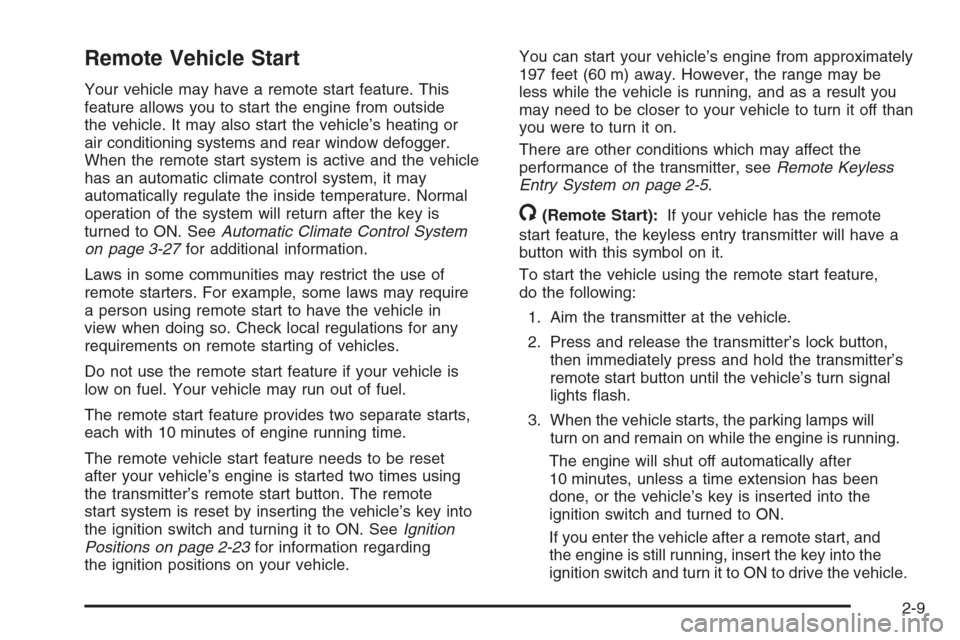
Remote Vehicle Start
Your vehicle may have a remote start feature. This
feature allows you to start the engine from outside
the vehicle. It may also start the vehicle’s heating or
air conditioning systems and rear window defogger.
When the remote start system is active and the vehicle
has an automatic climate control system, it may
automatically regulate the inside temperature. Normal
operation of the system will return after the key is
turned to ON. SeeAutomatic Climate Control System
on page 3-27for additional information.
Laws in some communities may restrict the use of
remote starters. For example, some laws may require
a person using remote start to have the vehicle in
view when doing so. Check local regulations for any
requirements on remote starting of vehicles.
Do not use the remote start feature if your vehicle is
low on fuel. Your vehicle may run out of fuel.
The remote start feature provides two separate starts,
each with 10 minutes of engine running time.
The remote vehicle start feature needs to be reset
after your vehicle’s engine is started two times using
the transmitter’s remote start button. The remote
start system is reset by inserting the vehicle’s key into
the ignition switch and turning it to ON. SeeIgnition
Positions on page 2-23for information regarding
the ignition positions on your vehicle.You can start your vehicle’s engine from approximately
197 feet (60 m) away. However, the range may be
less while the vehicle is running, and as a result you
may need to be closer to your vehicle to turn it off than
you were to turn it on.
There are other conditions which may affect the
performance of the transmitter, seeRemote Keyless
Entry System on page 2-5.
/(Remote Start):If your vehicle has the remote
start feature, the keyless entry transmitter will have a
button with this symbol on it.
To start the vehicle using the remote start feature,
do the following:
1. Aim the transmitter at the vehicle.
2. Press and release the transmitter’s lock button,
then immediately press and hold the transmitter’s
remote start button until the vehicle’s turn signal
lights �ash.
3. When the vehicle starts, the parking lamps will
turn on and remain on while the engine is running.
The engine will shut off automatically after
10 minutes, unless a time extension has been
done, or the vehicle’s key is inserted into the
ignition switch and turned to ON.
If you enter the vehicle after a remote start, and
the engine is still running, insert the key into the
ignition switch and turn it to ON to drive the vehicle.
2-9
Page 99 of 442

PASS-Key®III+ Operation
Your vehicle is equipped with PASS-Key®III +
(Personalized Automotive Security System)
theft-deterrent system. PASS-Key
®III + is a passive
theft-deterrent system. This means you don’t have to do
anything special to arm or disarm the system. It works
when you insert or remove the key from the ignition.
When the PASS-Key
®III + system senses that someone
is using the wrong key, it shuts down the vehicle’s starter
and fuel systems. The starter will not work and fuel will
stop �owing to the engine. Anyone using a trial-and-error
method to start the vehicle will be discouraged because
of the high number of electrical key codes.
When trying to start the vehicle if the engine does not
start and the security light comes on, the key may have a
damaged transponder. Turn the ignition off and try again.
If the engine still does not start, and the key appears
to be undamaged, try another ignition key. At this
time, you may also want to check the fuse, see
Fuses on page 5-99. If the engine still does not
start with the other key, your vehicle needs service.
If your vehicle does start, the �rst key may be faulty.See your dealer who can service the PASS-Key
®III +
to have a new key made. In an emergency, contact
Chevrolet Roadside Assistance. SeeRoadside
Assistance Program on page 7-6for more information.
It is possible for the PASS-Key
®III + decoder to
“learn” the transponder value of a new or replacement
key. Up to 10 additional keys may be programmed
for the vehicle. The following procedure is for
programming additional keys only. If all the currently
programmed keys are lost or do not operate, you must
see your dealer or a locksmith who can service
PASS-Key
®III + to have keys made and programmed
to the system.
See your GM dealer or a locksmith who can service
PASS-Key
®III + to get a new key blank that is cut
exactly as the ignition key that operates the system.
2-21
Page 104 of 442
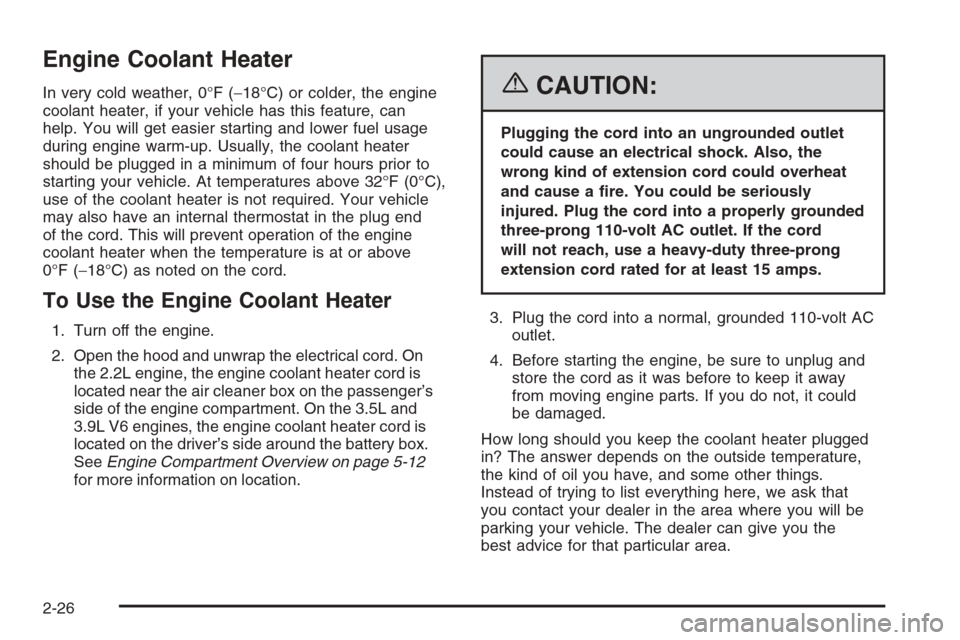
Engine Coolant Heater
In very cold weather, 0°F (−18°C) or colder, the engine
coolant heater, if your vehicle has this feature, can
help. You will get easier starting and lower fuel usage
during engine warm-up. Usually, the coolant heater
should be plugged in a minimum of four hours prior to
starting your vehicle. At temperatures above 32°F (0°C),
use of the coolant heater is not required. Your vehicle
may also have an internal thermostat in the plug end
of the cord. This will prevent operation of the engine
coolant heater when the temperature is at or above
0°F (−18°C) as noted on the cord.
To Use the Engine Coolant Heater
1. Turn off the engine.
2. Open the hood and unwrap the electrical cord. On
the 2.2L engine, the engine coolant heater cord is
located near the air cleaner box on the passenger’s
side of the engine compartment. On the 3.5L and
3.9L V6 engines, the engine coolant heater cord is
located on the driver’s side around the battery box.
SeeEngine Compartment Overview on page 5-12
for more information on location.
{CAUTION:
Plugging the cord into an ungrounded outlet
could cause an electrical shock. Also, the
wrong kind of extension cord could overheat
and cause a �re. You could be seriously
injured. Plug the cord into a properly grounded
three-prong 110-volt AC outlet. If the cord
will not reach, use a heavy-duty three-prong
extension cord rated for at least 15 amps.
3. Plug the cord into a normal, grounded 110-volt AC
outlet.
4. Before starting the engine, be sure to unplug and
store the cord as it was before to keep it away
from moving engine parts. If you do not, it could
be damaged.
How long should you keep the coolant heater plugged
in? The answer depends on the outside temperature,
the kind of oil you have, and some other things.
Instead of trying to list everything here, we ask that
you contact your dealer in the area where you will be
parking your vehicle. The dealer can give you the
best advice for that particular area.
2-26
Page 106 of 442
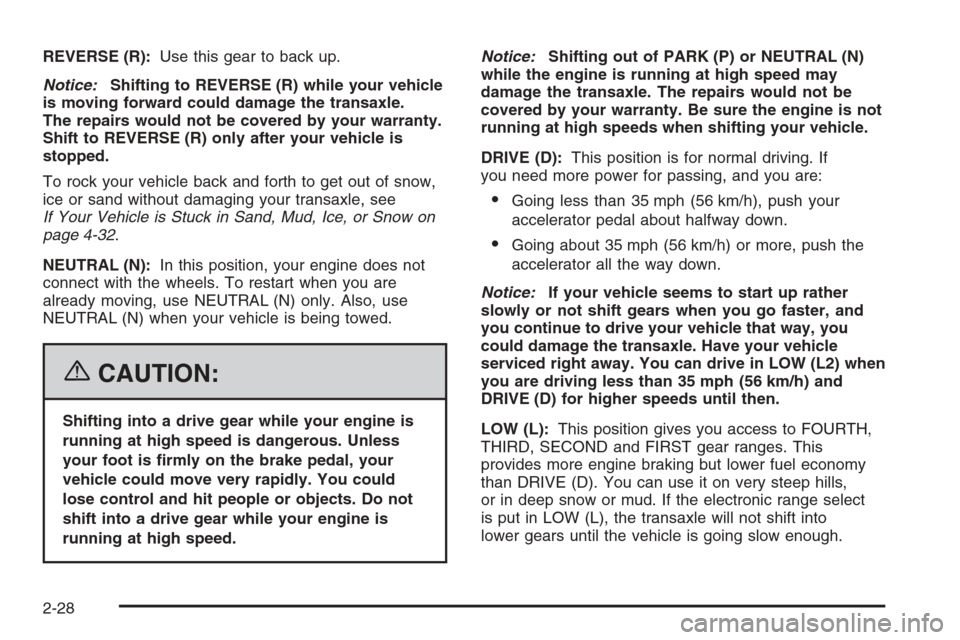
REVERSE (R):Use this gear to back up.
Notice:Shifting to REVERSE (R) while your vehicle
is moving forward could damage the transaxle.
The repairs would not be covered by your warranty.
Shift to REVERSE (R) only after your vehicle is
stopped.
To rock your vehicle back and forth to get out of snow,
ice or sand without damaging your transaxle, see
If Your Vehicle is Stuck in Sand, Mud, Ice, or Snow on
page 4-32.
NEUTRAL (N):In this position, your engine does not
connect with the wheels. To restart when you are
already moving, use NEUTRAL (N) only. Also, use
NEUTRAL (N) when your vehicle is being towed.
{CAUTION:
Shifting into a drive gear while your engine is
running at high speed is dangerous. Unless
your foot is �rmly on the brake pedal, your
vehicle could move very rapidly. You could
lose control and hit people or objects. Do not
shift into a drive gear while your engine is
running at high speed.Notice:Shifting out of PARK (P) or NEUTRAL (N)
while the engine is running at high speed may
damage the transaxle. The repairs would not be
covered by your warranty. Be sure the engine is not
running at high speeds when shifting your vehicle.
DRIVE (D):This position is for normal driving. If
you need more power for passing, and you are:
Going less than 35 mph (56 km/h), push your
accelerator pedal about halfway down.
Going about 35 mph (56 km/h) or more, push the
accelerator all the way down.
Notice:If your vehicle seems to start up rather
slowly or not shift gears when you go faster, and
you continue to drive your vehicle that way, you
could damage the transaxle. Have your vehicle
serviced right away. You can drive in LOW (L2) when
you are driving less than 35 mph (56 km/h) and
DRIVE (D) for higher speeds until then.
LOW (L):This position gives you access to FOURTH,
THIRD, SECOND and FIRST gear ranges. This
provides more engine braking but lower fuel economy
than DRIVE (D). You can use it on very steep hills,
or in deep snow or mud. If the electronic range select
is put in LOW (L), the transaxle will not shift into
lower gears until the vehicle is going slow enough.
2-28
Page 107 of 442
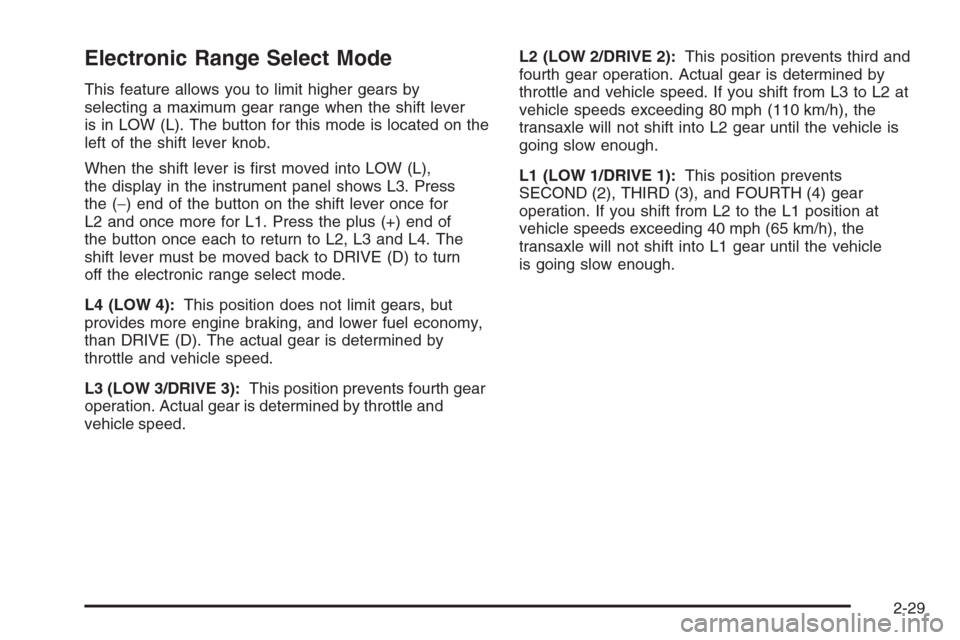
Electronic Range Select Mode
This feature allows you to limit higher gears by
selecting a maximum gear range when the shift lever
is in LOW (L). The button for this mode is located on the
left of the shift lever knob.
When the shift lever is �rst moved into LOW (L),
the display in the instrument panel shows L3. Press
the (−) end of the button on the shift lever once for
L2 and once more for L1. Press the plus (+) end of
the button once each to return to L2, L3 and L4. The
shift lever must be moved back to DRIVE (D) to turn
off the electronic range select mode.
L4 (LOW 4):This position does not limit gears, but
provides more engine braking, and lower fuel economy,
than DRIVE (D). The actual gear is determined by
throttle and vehicle speed.
L3 (LOW 3/DRIVE 3):This position prevents fourth gear
operation. Actual gear is determined by throttle and
vehicle speed.L2 (LOW 2/DRIVE 2):This position prevents third and
fourth gear operation. Actual gear is determined by
throttle and vehicle speed. If you shift from L3 to L2 at
vehicle speeds exceeding 80 mph (110 km/h), the
transaxle will not shift into L2 gear until the vehicle is
going slow enough.
L1 (LOW 1/DRIVE 1):This position prevents
SECOND (2), THIRD (3), and FOURTH (4) gear
operation. If you shift from L2 to the L1 position at
vehicle speeds exceeding 40 mph (65 km/h), the
transaxle will not shift into L1 gear until the vehicle
is going slow enough.
2-29
Page 134 of 442
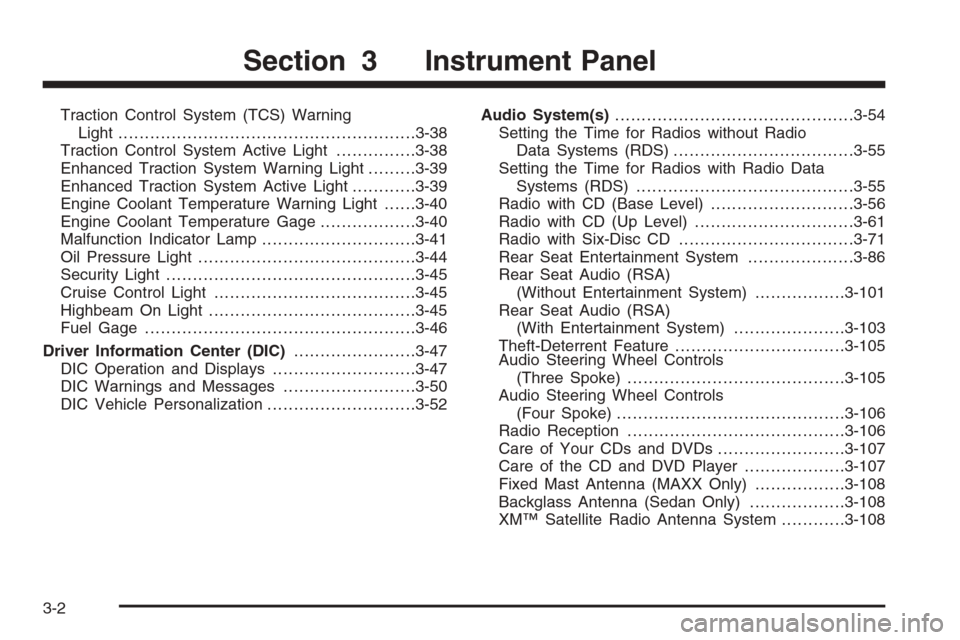
Traction Control System (TCS) Warning
Light........................................................3-38
Traction Control System Active Light...............3-38
Enhanced Traction System Warning Light.........3-39
Enhanced Traction System Active Light............3-39
Engine Coolant Temperature Warning Light......3-40
Engine Coolant Temperature Gage..................3-40
Malfunction Indicator Lamp.............................3-41
Oil Pressure Light.........................................3-44
Security Light...............................................3-45
Cruise Control Light......................................3-45
Highbeam On Light.......................................3-45
Fuel Gage...................................................3-46
Driver Information Center (DIC).......................3-47
DIC Operation and Displays...........................3-47
DIC Warnings and Messages.........................3-50
DIC Vehicle Personalization............................3-52Audio System(s).............................................3-54
Setting the Time for Radios without Radio
Data Systems (RDS)..................................3-55
Setting the Time for Radios with Radio Data
Systems (RDS).........................................3-55
Radio with CD (Base Level)...........................3-56
Radio with CD (Up Level)..............................3-61
Radio with Six-Disc CD.................................3-71
Rear Seat Entertainment System....................3-86
Rear Seat Audio (RSA)
(Without Entertainment System).................3-101
Rear Seat Audio (RSA)
(With Entertainment System).....................3-103
Theft-Deterrent Feature................................3-105
Audio Steering Wheel Controls
(Three Spoke).........................................3-105
Audio Steering Wheel Controls
(Four Spoke)...........................................3-106
Radio Reception.........................................3-106
Care of Your CDs and DVDs........................3-107
Care of the CD and DVD Player...................3-107
Fixed Mast Antenna (MAXX Only).................3-108
Backglass Antenna (Sedan Only)..................3-108
XM™ Satellite Radio Antenna System............3-108
Section 3 Instrument Panel
3-2
Page 165 of 442

Instrument Panel Cluster
Your instrument panel cluster is designed to let you know at a glance how your vehicle is running. You’ll know how
fast you’re going, how much fuel you’re using, and many other things you will need to drive safely and economically.
Your vehicle has this instrument panel cluster, which includes indicator warning lights and gages that are explained
on the following pages.
United States Base version shown, Canada and SS Model Similar
3-33